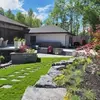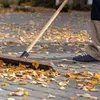Paved stone trends
- Date : Friday, January 13th, 2023
- Read time : 4 min
More and more of our landscaping is composed of flower beds, trees and shrubs, turf or decorative evergreens. To ensure that all of these plants look healthy and perform to their full potential, watering is a key factor. To avoid softening of your flowers, yellowing of your leaves or dehydration of your lawn, you need to water properly. But what is the ideal amount and frequency? Should you water the same way for all types of plants? Find out more information and some tips for proper watering of your plants.
UNIFORM WATERING
For outdoor plants, it is important to continue to water regularly and to ensure that the soil receives the same amount of water. It is wise to check the producer's advice, as some plants prefer a slight dehydration between waterings to optimize root growth.
Depending on the level of sunlight and the type of soil, the beds can be watered once or twice a week. Be sure to leave your leaves dry. Opt for watering underneath the leaves to avoid disease proliferation or sunburn.
Water needs a while to reach the roots, and since it is not recommended to create puddles in your garden or flowerbeds, make sure to have a light and more prolonged watering.
The automatic watering systems are perfectly designed to offer a constant and economical watering. Thanks to its humidity sensor, the system can start autonomously or manually. A practical tool for flowerbeds and lawns.
WATERING IN THE MORNING, DAY OR EVENING?
The time to water often depends on the temperature. In very hot weather, it is best to water early in the morning to give the plants time to absorb water before the temperature rises. Otherwise, opt for an evening watering so that the water does not evaporate as quickly and the roots get their energy back.
THE CHOICE OF SOIL AND MULCH
Soil rich in clay minerals has better growth properties, retains minerals better and absorbs water particularly well. On humid summer days or during winter, this type of soil favors water drainage, avoids puddles and allows the roots to obtain all the water they need to grow.
To optimize moisture retention, consider using mulch. Mulching prevents the growth of many weeds, uses less water, increases the presence of microfauna, including earthworms, and therefore increases plant growth. In addition to being a thermal buffer, it reduces evaporation and increases the aesthetic aspect of your flowerbeds.
For a quality landscaping project, entrust your work to a team of experts.






